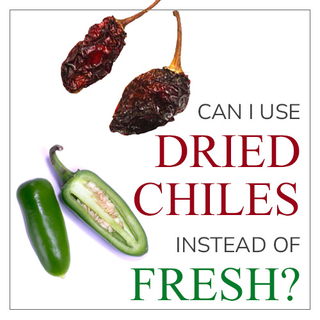Can I Use Dried Chiles Instead of Fresh?

Can I Use Dried Chiles Instead of Fresh
For all practical purposes, we would say they can’t be used interchangeably. Dried chiles come from fresh chile peppers, so it’s understandable that one would ask if you can just take dried chiles and start using them in recipes where fresh chiles are normally found. The drying process turns a fresh chile into a completely different sort of pepper, with its own texture and flavor profile. For example, a fresh green poblano pepper is bracing and grassy, but when it’s allowed to mature to redness and then dried, it becomes a plummy, raisiny Ancho. When it’s given the opportunity to ripen fully until it is almost brown on the vine, its flavor turns earthy and smoky, with hints of chocolate and licorice and changes names again. When a poblano is dried at its final stage of ripeness and develops these rich flavors, it is known as a Mulato chile.
Is Dried Chile Hotter Than Fresh
In a word, yes, dried chiles are hotter than their fresh counterparts. We can turn to science to explain why this is the case.
Capsaicin is a chemical compound that lives in the membranes, seeds, and white pith inside a pepper, and it is the fuel that drives a chile pepper’s heat. As a pepper dries, water evaporates from its cells, so the pepper becomes thinner as it loses its water weight. Capsaicin, however, is not water-soluble, so it doesn’t evaporate away and instead concentrates as it remains in the cells of the pepper. Without the thicker flesh of a fresh chile to hide behind, the spicy capsaicin becomes more prevalent. Fresh peppers and dried chiles will measure the same in terms of Scoville Heat Units, because that testing is done with a distillation taken from a pepper; it analyzes the chemical makeup of the pepper and not the pepper itself. By weight, dried peppers contain more concentrated capsaicin than the same pepper in its fresh form.
What Can I Use Instead Of Fresh Chiles
You can always decide not to use chile peppers, if you aren’t a fan of spicy food, or add a sweet, mild dried chile for a flavor boost without the heat. If you like a recipe and want a substitute for fresh chiles that will add crunch without any chile pepper heat, use fresh red or green bell peppers. The green bell pepper will be mild and a little bit astringent and grassy, while the red bell pepper will be mild and sweet. If you’re interested in a little bit of peppery heat and want some crunch but just can’t get to the store for chile peppers, fresh radishes are a good substitute. They’re bracing and have a bit of a bite, but they should only be added at the end of a dish. The compounds that give radishes their heat are water-soluble, so when you cook them, the radishes turn mellow and sweet.
Because fresh and dried chiles have such strong differences in flavor, we don’t recommend substituting a chipotle, for example, if your recipe calls for a jalapeno. You won’t get crisp, fresh heat but rather, nuanced berry and smoky flavors. Instead, if you want a bit of heat but just don’t have a fresh chile on hand, you can try sprinkling in a bit of chile powder, like Cayenne. Cayenne is spicy but doesn’t have a strong flavor, so start by adding a very small amount to a dish to see how the heat affects the flavor; you can always add more heat, but you can’t take it out once it’s in there!
Fresh Chiles to Chile Flakes Conversion
Do you want to use chile flakes instead of fresh chiles and need to figure out just how much flaked chile to use? Converting fresh chiles into chile flakes requires that you take a lot of factors into consideration, and the first among this is the nature of dried chiles vs. fresh peppers. One pound of fresh peppers will give you approximately 4 ounces of dried chiles, so one tablespoon of chile flakes is about 4 times as potent as one tablespoon of freshly-chopped chiles. Remember, the weight and bulk of the pepper may change as it dries but the capsaicin remains.
You also need to think about how old the chile flakes are. Whole dried chiles retain their flavor and potency longer than flaked chiles, especially if they’re stored properly in something air-tight and protected from light and moisture. But they won’t stay in their newly-dried, nuanced and pungent state forever, and will eventually degrade over time. While you may think you know how powerful your chile flakes are, it would be best to give them a small taste before using to double-check them for expected heat and flavor. Old chile flakes are not usually subject to mold unless moisture has been introduced into their storage container so they won’t make you sick. They’ll just be disappointing.
And finally, please remember that chile flakes are not interchangeable. They may look small and unassuming but looks can be deceiving. A teaspoon of Guajillo Chile Flakes will deliver a fun and fruity burn, but a teaspoon of Carolina Reaper Chile Flakes will light you on fire. So what do you do if you want to use chile flakes instead of fresh chiles? Make sure you choose flakes with the appropriate heat level that suits your taste. Add flakes to a recipe in small increments, so you don’t over-season with them, and try to use the freshest flakes possible for the best heat and flavor.

